504 vs. IEP: Tailored Treatments in Education
Navigating getting support for your child, teen, or young adult struggling in school or college is complicated for most parents. The process is challenging, and the rules seem hidden. You may have asked your friends, your physician, or even your child's teacher and still need to figure out how to get the right help for your child.
When your child isn't successful in school or life, there is nothing more important than getting them solutions. You need the right path to getting more help at school so your child can learn.
Table of Contents
Chapter 2: What is the Individuals with Disabilities Education Act (IDEA)?
Chapter 3: Key Features of an IEP
Chapter 4: Who Qualifies for an IEP?
Chapter 5: Common Issues Why Students Need an IEP
Chapter 6: What is the Purpose of an IEP?
Chapter 7: Types of Services and Accommodations Available Through an IEP
Chapter 8: Advantages and Disadvantages of an IEP
Chapter 9: How do I Know if my Child Needs an IEP?
Chapter 10: What is the Process of Obtaining an IEP?
Chapter 11: How Can I Help My Child on an IEP?
Chapter 12: Understanding 504 Plans
Chapter 13: What is the Purpose of a 504 Plan?
Chapter 14: Eligibility Requirements for a 504 Plan
Chapter 15: Major Life Activities as Defined in Section 504
Chapter 16: Common Issues That Need Accommodations
Chapter 17: Timeline Guidance on a 504 Plan
Chapter 18: Types of Accommodations and Services Available Through a 504 Plan
Chapter 19: Advantages and Disadvantages of a 504 Plan
Chapter 20: What Qualifies a Student for an IEP vs. a 504?
Chapter 21: IEP vs. 504 Basics
Chapter 22: What is The Process of Obtaining a 504 Accommodation Plan?
Chapter 23: What Kind of Evaluation is Required for a 504 Accommodation Plan?
Chapter 24: How do I Know if my Child Needs a 504?
Chapter 25: Comparing 504 Plans and IEPs
Chapter 26: 6 Factors to Consider When Deciding Between a 504 Plan and an IEP
Chapter 27: 504 Plan vs. IEP: Which is More Appropriate for Your Child's Needs?
Chapter 28: 7 Tips for Advocating for Your Child During the 504 Plan or an IEP Process
Chapter 29: Solutions for Students with Special Needs and Mental Health Issues
For children with a disability, they may qualify for IEP special education services or a 504 Accommodation Plan. Parents may be familiar with these terms but not understand their meaning or how their child would benefit from these federal disability programs.
All schools that receive federal monies are obligated under federal law to provide students with disabilities accommodations under a 504 plan or if they qualify for an IEP in a general education setting.
Both an IEP and a 504 Plan are federal programs that allow students with learning difficulties to receive help if they qualify, but they are a quite different.
Chapter 1:
What is an IEP?
Students with a disability who need direct support in school may be eligible for special education services (SPED) through an Individualized Education Program (IEP). Under federal Individuals with Disabilities Education IDEA law, an IEP is offered free of charge to families of kids in public schools and school districts have an obligation to find students with disabilities (Section 300.01 Child Find Provisions).
An Individualized Educational Plan is a formal written document that details a student's disability, goals and objectives, and services that relate to receiving specialized instruction that’s developed for each public school student who receives special education. This plan is developed to help a child with a disability to succeed in school.
With laws behind it, the IEP has formal processes. It is created through a team effort and reviewed at least once a year with additional provisions about the assessment of the student to continue receiving services.
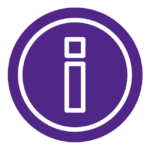
Before an IEP can be written, your child must be eligible for special education. By federal law, a multidisciplinary team must determine that:
(1) she’s a child with a disability and
(2) she requires special education and related services to benefit from the general education program.
Chapter 2:
What is the Individuals with Disabilities Education Act (IDEA)?
The Individuals with Disabilities Education Act is the federal statute that supports special education and related service programming for children with disabilities. It was originally passed as an act in 1975 and additional amendments were passed to ensure equal access for all students to education.
Although the disabilities education act IDEA is a federal law that requires certain information to be included in the IEP, it doesn't specify how the IEP should look in every state or school district. As a result, forms differ from state to state and may vary between school systems within a state, which can confuse parents as they navigate the world of special education.
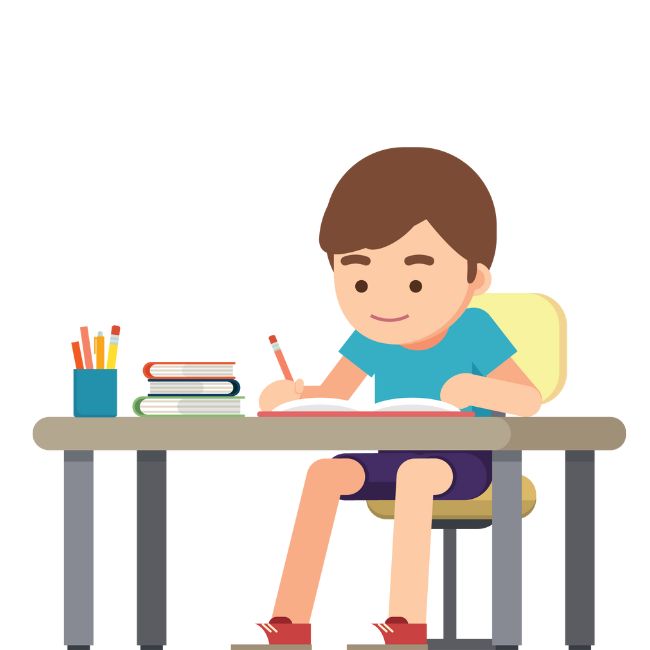
This federal legislation is designed to ensure that children with disabilities be granted free appropriate public education (FAPE) in the least restrictive environment (LRE). It means that students with disabilities have a right to be educated in their school districts and within the regular education classroom as much as possible.
An IEP includes the child's present academic achievement and functional performance levels, which describes how the child's disability impacts them in the general education curriculum.
Chapter 3:
Key Features of an IEP:
Creating an individualized education plan is a complex process from start to finish. Here are some essential features of an IEP.
An IEP requires:
- Development by a team
- Measurable annual goals
- Progress reporting
- Annual review of the progress on goals and objectives
- Program modifications and accommodation supports
- Special education, related services, and supplemental aids and services
- Description of service delivery
- Participation in state and district‑wide tests
- Least Restrictive Environment statement
- Postsecondary transition components
- Transition services and activities
IDEA legislation ensures that:

- All children identified with a disability receive special education and related services to address their individual needs through age 22.
- With guidelines and processes, the rights of children with disabilities and their families are protected under the law.
- Children with disabilities are prepared for employment and independent living.
- Has provisions to monitor institutions' efforts to provide services to persons with disabilities.
- Gives aid to states, localities, federal agencies, and educational service agencies in providing for the education of children with disabilities.
Chapter 4:
An IEP covers all school-aged children who fall within one or more specific categories of qualifying conditions. There are 13 categories for which students qualify to receive free and appropriate education in special education:
- Autism
- Deaf-blindness
- Deafness
- Emotional Disturbance
- Hearing Impairment
- Intellectual Disability
- Multiple Disabilities
- Orthopedic Impairment
- Other Health Impairment (OHI) (ADHD, PANS/PANDAS, etc.)
- Specific Learning Disability (SLD) (Dyslexia, etc.)
- Speech or Language Impairment (SLI)
- Traumatic Brain Injury (TBI)
- Visual Impairment (VI)
Chapter 5:
Common Issues Why Students Need an IEP
Many clinical issues result in needing an IEP. With that being said, just because your child or teen has a diagnosis doesn't mean they are guaranteed an IEP (or 504). There must be an area that requires individualized instruction and specific remediation.
- Autism Spectrum Disorder (ASD)
- Attention-Deficit/Hyperactivity Disorder (ADHD)
- Specific Learning Disability (SLD), such as dyslexia or dyscalculia
- Emotional Disturbance (ED), including depression, anxiety, or bipolar disorder
- Intellectual Disability (ID)
- Speech and Language Impairment (SLI)
- Visual or Hearing Impairment
- Traumatic Brain Injury (TBI)
- Physical Disabilities or Health Impairments, such as cerebral palsy or epilepsy
- Developmental Delay (DD)
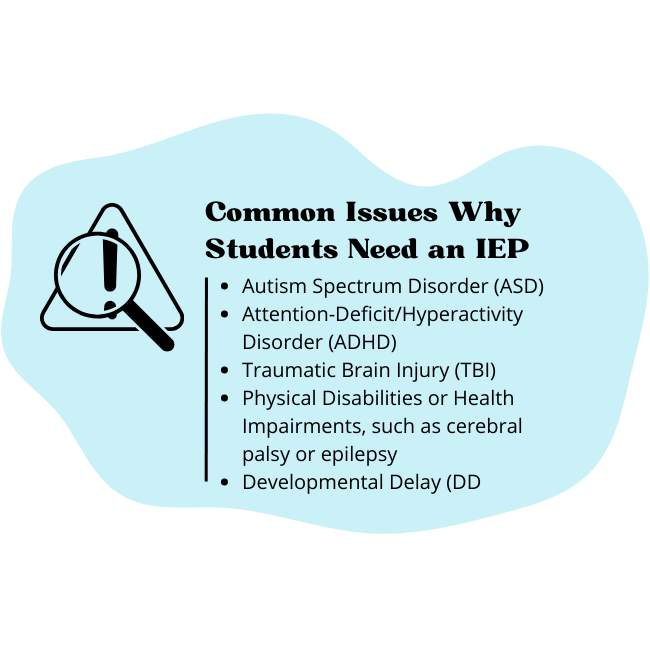

It's important to note that the specific clinical issues and disabilities covered by an IEP may vary depending on the individual student's needs and the evaluation and assessment process.
Chapter 6:
At the most basic level, an IEP provides a student with the necessary services, supports, and accommodations to give them access to and benefit from their education. It helps a child learn in the public school classroom with the resources and support they need.
When an IEP is done well, it is supposed to address the specific areas where there is a gap between student ability and student performance, as data indicates. Special education and related services should be explicitly designed to meet the unique needs of each eligible student. A plan should be created to fit a student's needs and not the student's needs being forced into a program.
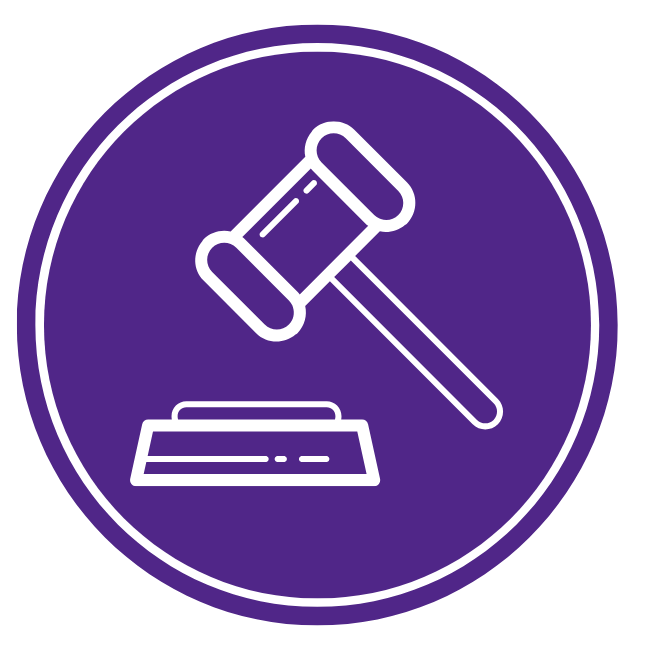
Chapter 7:
The types of services and accommodations available through an IEP will be tailored to the child's specific needs and may change over time as the child's needs change. The IEP team, which includes parents, teachers, and other school personnel, is responsible for developing and implementing the child's IEP.
Some Possible Examples of Services Included in an IEP
Special Education Services
These services are provided to students identified as having a disability that impacts their ability to learn. Examples of special education services include resource room instruction, individual or small group instruction, or special education classes.
Related Services
Related services are additional services necessary for a student with a disability to benefit from their education. Associated services include occupational therapy, physical therapy, speech and language therapy, and counseling.
Accommodations and Modifications
Accommodations and modifications are changes to the learning environment or curriculum that help students with disability access and participate in their education. Examples of accommodations and modifications include extended time on tests, use of assistive technology, preferential seating, and simplified language.
Transition Services
Transition services are designed to help students with disabilities prepare for life after high school. Examples of transition services include vocational training, job coaching, and independent living skills instruction.

Assistive Technology
Assistive technology refers to devices or software that help students with disabilities access and participate in their education. Examples of assistive technology include speech-to-text software, magnification devices, and text-to-speech software.
Chapter 8:
Advantages and Disadvantages of an IEP
As a parent, you want the best education for your child, including ensuring their individual needs are met. For children with disabilities, an Individualized Education Program can provide the necessary accommodations and services to help them succeed in school.
While IEPs can offer many benefits to children with disabilities, it's essential to know that there are also potential drawbacks.

Advantages of an IEP
Individualized approach
IEPs are tailored to the unique needs of each student with a disability, ensuring they receive the accommodations and services needed to succeed in school.
Legal protection
An IEP is a legally binding document outlining the educational services and accommodations a school district must provide to a student with a disability.
Accountability
Schools must track and report on the student's progress toward their IEP goals, ensuring they are making meaningful progress and receiving the services and accommodations they need to succeed.
Collaboration
The development and implementation of an IEP involves a team of individuals, including parents, teachers, and other school personnel, who work collaboratively to support the student's educational needs.
Disadvantages of an IEP
Lengthy and complex process
Developing an IEP requires significant time, effort, and collaboration between parents, educators, and other professionals.
Potential for disagreement
Disagreements may arise between parents and school personnel regarding the development or implementation of the IEP, resulting in a communication breakdown and a delay in services.
Stigmatization
Some students may feel stigmatized or singled out because they have an IEP, affecting their self-esteem and sense of belonging in the school community.
Limited focus
While an IEP provides individualized services and accommodations for students with disabilities, it may not address broader systemic issues that affect the educational experiences of all students, such as inadequate funding or teacher training.
Overall, the benefits of an IEP generally outweigh any potential drawbacks as long as parents and educators work collaboratively to develop and implement the plan and remain focused on the student's best interests.
Chapter 9:
How do I Know if my Child Needs an IEP?
If you have concerns about your child's academic or behavioral performance, it may be worth exploring whether an IEP could benefit them. An IEP provides for individualized instruction and remediation of specific issues, and with that remediation, your child could access free and appropriate education (FAPE).
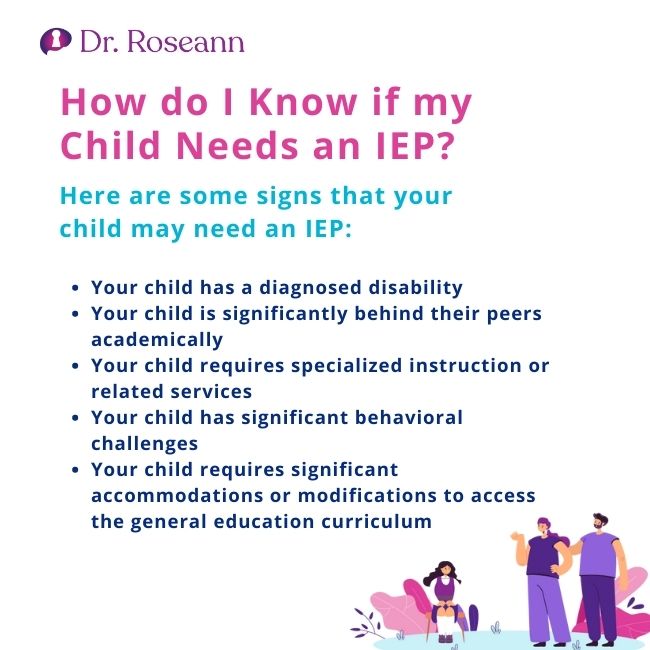
Here are some signs that your child may need an IEP:
- Your child has a diagnosed disability: If your child has a diagnosed disability that affects their ability to learn and access the general education curriculum, they may be eligible for an IEP.
- Your child is significantly behind their peers academically: If your child is significantly behind their peers academically, despite receiving appropriate instruction and interventions, an IEP may be necessary to provide more individualized support.
- Your child requires specialized instruction or related services: If your child needs specialized instruction or related services, such as speech therapy, occupational therapy, or counseling, an IEP may be necessary to ensure they receive the support they need.
- Your child has significant behavioral challenges: If your child has substantial behavioral challenges impacting their ability to learn or participate in school, an IEP may be necessary to address the underlying issues and provide support and accommodations.
- Your child requires significant accommodations or modifications to access the general education curriculum: If your child requires significant accommodations or modifications, such as access to assistive technology or extended time on tests, to access the general education curriculum, an IEP may be necessary to ensure that they receive the support they need.
An IEP may be necessary to provide the direct and individualized instruction and accommodations a child’s need to succeed in school. Discussing your concerns with your child's teacher or school counselor is vital to determine if an IEP is appropriate. If you are still unsure, an educational advocate can help you through this process.
Chapter 10:
What is the Process of Obtaining an IEP?
There are clear rules and regulations for identifying a child with special needs and evaluation procedures. Under child find, school districts are legally obligated to “find” students who need special education support to learn in multiple areas.
Here are the steps a parent should take when asking for special education support:
Step 1: Request an evaluation
If you suspect that your child has a disability that is impacting their education, you can request an evaluation from your child's school. This can be done in writing to your child's teacher, principal, or school counselor. Once the request is received, the school will initiate the evaluation process.
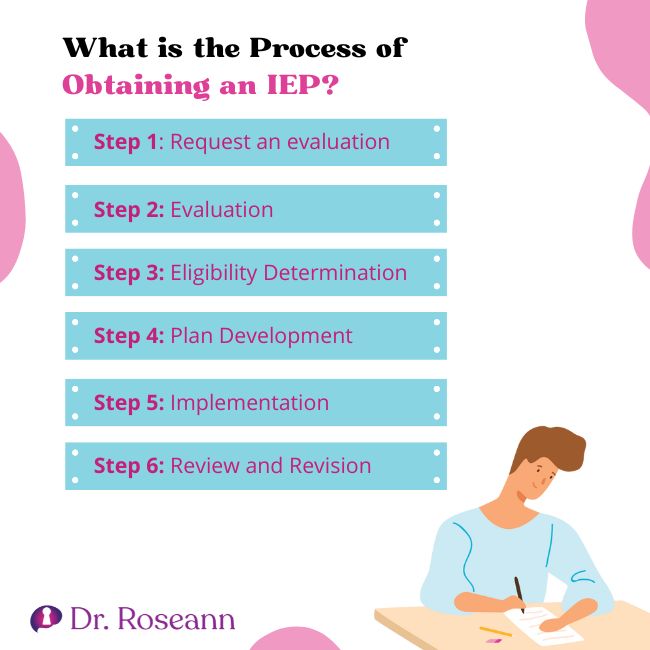
Step 2: Evaluation
The evaluation will be conducted by a team of professionals, including the school psychologist, special education teacher, general education teacher, and other relevant specialists.
The evaluation will include reviewing your child's academic and developmental history, classroom observations, and assessments to determine if your child has a disability that qualifies for an IEP.
Step 3: Eligibility Determination
After the evaluation, the team will determine if your child is eligible for an IEP. For example, your child is found to have a disability that affects their ability to learn and access the general education curriculum and requires specialized instruction and related services. In that case, the team will develop a plan for your child.
Step 4: Plan Development
The team will develop a written plan that outlines the specialized instruction and related services your child will receive. The IEP will include goals that are specific, measurable, achievable, relevant, and time-bound (SMART), accommodations and modifications needed to access the general education curriculum, and any other services deemed necessary by the team.
Step 5: Implementation
Your child's school will implement the IEP. The school will be responsible for providing the specialized instruction and related services outlined in the plan.
Step 6: Review and Revision
The IEP will be reviewed and revised annually to ensure that it meets your child's needs. You will be included in this process and will have the opportunity to provide input.
Obtaining an IEP involves a process that includes evaluation, eligibility determination, plan development, implementation, and review and revision. It is crucial to work collaboratively with your child's school to ensure that your child's needs are being met.
Chapter 11:
How Can I Help My Child on an IEP?
The best way to help your child on an IEP is to concentrate on what you can do to support their brain and emotional development.
Celebrate Neurodiversity
All brains are unique and different, so we should teach children to celebrate their neurodiversity, so they can feel confident and love themselves.
Natural Attention Support
Children need to be able to pay attention to learn. There are many ways to improve attention naturally.
Teach the Teacher
Don’t assume school personnel understands clinical issues such as PANS/PANDAS, ADHD, OCD, Depression, or even learning issues such as dyslexia. It means providing them with resources about these clinical issues and specific tips from trusted experts are often appreciated.
Share Your Calm
Staying positive and using positive language is paramount in helping your child succeed in all life avenues. It starts with taking care of yourself and calming your brain and body.
Teach Kids About How Their Brain Works
When we teach children about their strengths and weaknesses, they can use that information to know themselves better and be better learners. Talking to kids about their diagnosis can be empowering.
Chapter 12:
Understanding 504 Plans
What is a 504 Accommodation Plan?
A 504 Accommodation Plan is a written plan that provides equal access to education for people with disabilities to succeed in academic and employment settings. It offers various accommodations that “level the playing field” for students through university.
This plan is designed to provide equal access to education for students with disabilities and can include extra time on tests or assistive technology. It is named after Section 504 of the Rehabilitation Act, which prohibits discrimination against individuals with disabilities in programs that receive federal funding.
Unlike an Individualized Education Program (IEP), specifically designed for students who need special education services, a 504 Accommodation Plan is available to any student with a disability who qualifies for the program. The plan is developed through a process that involves evaluation, discussion, and periodic review.
Chapter 13:
What is the Purpose of a 504 Plan?
The purpose of a 504 Plan is to provide students with disabilities equal access to education and other activities. It is supposed to ensure that students with disabilities are not discriminated against and have the same opportunities to participate in and benefit from educational programs as their non-disabled peers.
It does this by providing necessary accommodations and services that “level the playing field” for students with disabilities, removing barriers that might otherwise prevent them from succeeding in school.
The accommodations and services provided through a 504 Plan can vary depending on the student's individual needs. They may include extra time on tests, preferential seating, assistive technology, or modifications to the curriculum.
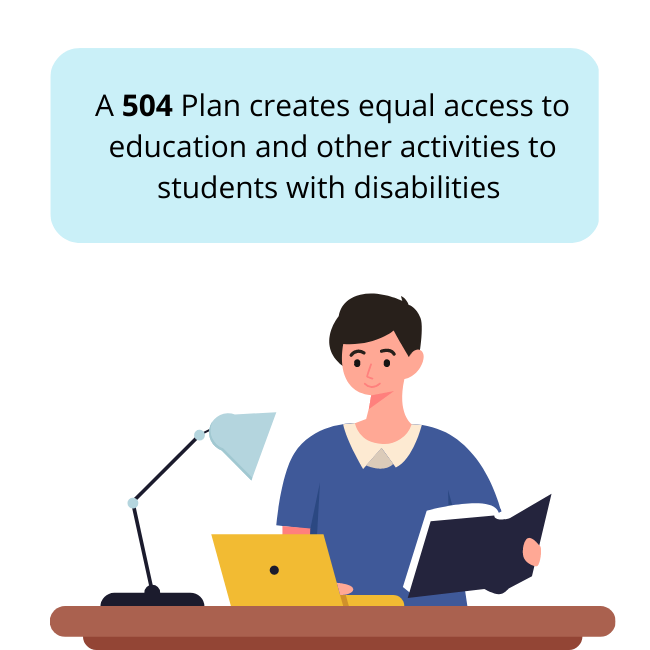
Chapter 14:
Eligibility Requirements for a 504 Plan
It's important to note that eligibility for a 504 Plan is not based on the student's academic performance, but rather on the presence of a qualifying disability and its impact on their ability to access and participate in educational programs.
Eligibility Requirements for a 504 Plan
- The student must have a physical or mental impairment that substantially limits one or more major life activities, such as learning, seeing, hearing, or walking.
- The impairment must significantly impact the student's ability to access and participate in educational programs and activities.
- The impairment must be evaluated and documented through appropriate assessments and evaluations, including medical records, observations, and input from parents, teachers, and other professionals.
- The student must be otherwise qualified to participate in the program or activity, meaning that they meet the academic and other requirements for the program or activity.
How a disability impacts a student becomes one of the most contentious parts of securing a 504 for your child. School personnel who don’t fully understand 504 often think a student must be “failing” in school to need accommodations but that isn’t the case.
There must be an impact on the student in one of these major life activities. But, on the flip side, just because a student has a diagnosis doesn't mean they require an accommodation plan unless there is an impact.
Chapter 15:
Major Life Activities as Defined in Section 504
One of the critical components of Section 504 is the definition of major life activities. Major life activities refer to a range of daily activities central to an individual's life, such as walking, seeing, hearing, and learning.
- caring for one’s self
- performing manual tasks
- walking
- seeing
- hearing
- speaking
- breathing
- learning
- working
- eating
- sleeping
- standing
- lifting
- bending
- reading
- concentrating
- thinking
- communicating
Chapter 16:
Common Issues That Need Accommodations
There are many reasons students with disabilities have accommodations, and here are some of the most common causes.
- Attention-Deficit/Hyperactivity Disorder (ADHD)
- Dyslexia and other Specific Learning Disabilities (SLDs)
- Autism Spectrum Disorder (ASD)
- Emotional and Behavioral Disorders (EBD)
- Intellectual Disabilities (ID)
- Visual or Hearing Impairments
- Physical Disabilities or Health Impairments
- Traumatic Brain Injury (TBI)
- Anxiety Disorders
- Depression and other Mood Disorders

Chapter 17:
Timeline Guidance on a 504 Plan
The US Department of Education Office for Civil Rights (OCR) has provided guidelines for the Section 504 process, including evaluations. While there is no specific time requirement for school districts to complete an assessment, OCR will consider the IDEA timeline, state requirements, or local district policies to determine whether the time it takes to evaluate a student is reasonable after parental consent has been obtained.

It is important to note that school districts can be in violation of Section 504 if they deny or delay an
evaluation for a student with a suspected disability that requires special education or related services.
Therefore, educators and school staff must be aware of the signs and symptoms of potential disabilities and act accordingly to ensure timely evaluations and necessary accommodations for students in need.
Chapter 18:
Types of Accommodations and Services Available Through a 504 Plan
A 504 plan is designed to provide students with disabilities equal access to education and other activities by providing necessary accommodations and services. The types of accommodations and services available through a 504 plan can vary depending on the student's individual needs. Here are some examples:
Modifications to the Curriculum
It could include changes to how the material is presented or how assignments are completed to ensure the student can access and participate in the educational program. My FREE School Accommodations Guide has information for teachers on modifying the curriculum.
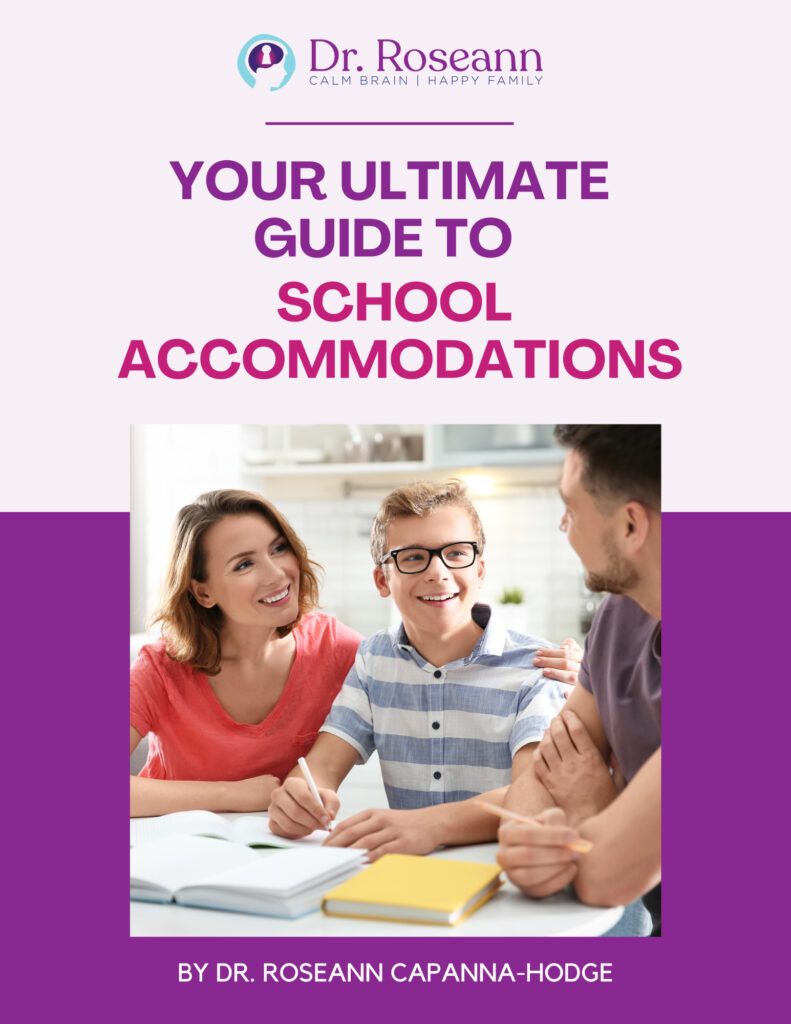
School Accommodations to Become
Your Child’s Best Advocate
➡️ Get the ultimate accommodations guide that has all of “the meat and none of the potatoes” with accommodations for more than 30 common issues and conditions
➡️ The exact accommodations you need for any school meeting or letter from a seasoned school psychologist and IEP and 504 meeting veteran
➡️Come prepared with the accommodations requests that actually can help your child at school
Assistive Technology
It could include using software or devices that help the student access and participate in educational programs, such as text-to-speech software or a tablet.
Changes to the Physical Environment
It could include changes to the physical space to improve access, such as the installation of ramps, elevators, or wheelchair-accessible tables.
Specialized Instruction or Support
It could include additional instruction or support from a special education teacher or other professional to address the student's unique needs.
Accommodations for Testing and Assessments
It could include extended time, taking breaks, or using assistive technology to complete assessments.
Behavioral Support
It could include a behavior plan or other strategies to address challenging behaviors that may interfere with the student's ability to access and participate in educational programs. There are many things teachers can do at school for students with ADHD and other clinical issues.
The specific accommodations and services provided through a 504 plan will depend on the student's individual needs and are determined through the evaluation and planning process.
Chapter 19:
Advantages and Disadvantages of a 504 Plan
Here are some potential advantages and disadvantages of a 504 plan for students with disabilities:
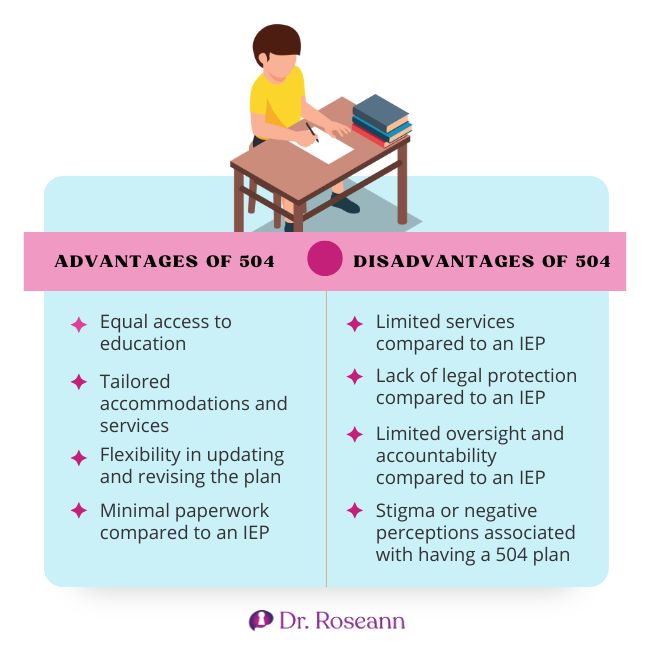
Advantages of a 504 Plan
- Equal access to education: EA 504 plan can ensure that students with disabilities have the same opportunities to access and participate in educational programs as their peers without disabilities.
- Tailored accommodations and services: The plan is designed to provide individualized accommodations and services that meet the student's unique needs.
- Flexibility: The plan can be updated and revised as the student's needs change.
- Minimal paperwork: Compared to an Individualized Education Program (IEP), a 504 plan involves less paperwork and is often easier to implement.
Disadvantages of a 504 Plan
- Limited services: Unlike an IEP, a 504 plan does not provide specialized instruction or related services. It is focused solely on providing accommodations and services to ensure equal access to education.
- Lack of legal protection: While a 504 plan is designed to prevent discrimination against students with disabilities, it does not offer the same legal protections as an IEP.
- Limited accountability: There needs to be more oversight and accountability for a 504 plan than for an IEP, making it more challenging to ensure that the student receives the necessary accommodations and services.
- Stigma: Some students may feel stigmatized by having a 504 plan, as it can highlight their differences from their peers without disabilities.
It's important to note that the advantages and disadvantages of a 504 plan will vary depending on the individual student's needs and circumstances.
Chapter 20:
What Qualifies a Student for an IEP vs. a 504?
There are essential differences between an IEP and 504 in how students are supported and in the implementation process.
Eligibility for an IEP is determined under the Individuals with Disabilities Education Act (IDEA). A student must have a disability that affects their ability to learn and access the general education curriculum. The disability must also require specialized instruction and related services, such as speech therapy, occupational therapy, or counseling.
Getting an IEP involves a formal evaluation, development of the IEP plan, and periodic reviews and updates. IEP’s are typically for students needing more comprehensive support and services and direct and individualized instruction.
On the other hand, eligibility for a 504 plan is determined under Section 504 of the Rehabilitation Act of 1973. A student must have a disability that substantially limits one or more major life activities, such as learning, reading, writing, or concentrating.
The disability must also require accommodations or modifications to access the general education curriculum and participate in school activities. The process for getting a 504 plan involves a formal evaluation (not necessarily standardized testing), development of the 504 plan, and periodic reviews and updates.
There are no formal goals and objectives that are measurable. 504 plans are typically for students who need accommodations and modifications to access the same educational opportunities as their peers.
One of the main differences between an IEP and a 504 plan is the level of support and services provided. An IEP provides specialized and individualized instruction and related services, while a 504 plan provides accommodations and modifications.
Additionally, IEPs have age limits, as they are available for students ages 3-21 (or until high school graduation). At the same time, there is no age limit for a 504 plan, and it can follow a student to college and employment.
It is important to note that not all students with disabilities will qualify for an IEP or a 504 plan. The eligibility criteria for each plan are specific and require formal evaluation and documentation. If you have concerns about your child's education, talk to their teacher or school counselor about your options for support and accommodations.
Chapter 21:
IEP vs. 504 Basics
| IEP | 504 | |
| Type of Law | Individuals with Disabilities Education Act (IDEA) | Section 504 of the Rehabilitation Act of 1973 |
| Department | U.S. Department of Education | Office of Civil Rights (OCR) |
| What it Does | Provides specialized instruction and related services | Provides accommodations and modifications |
| What is in it | A written plan that includes present levels of performance, annual goals, accommodations, modifications, and services. | A written plan that includes accommodations, modifications, and services. |
| Eligibility Requirement | The student has a disability that affects their ability to learn and access the general education curriculum, and requires specialized instruction and related services. | The student has a disability that substantially limits one or more major life activities, and requires accommodations or modifications to access the general education curriculum and participate in school activities. |
| Timeline | Has specific timeline limits for initial evaluations (60 days or less), and other process timelines. | There are no timeline limits but the OCR will look to IDEA, state guidelines and district policies. |
| What is Required | A formal evaluation, development of the IEP plan, and periodic reviews and updates. | A formal evaluation, development of the 504 plan, and periodic reviews and updates. |
| Age Limits | Ages 3-21 (or until high school graduation) | No age limit |
| Where is the Plan Used | Used in public schools that receive federal funding | Used in any school that receives federal funding and follows to employment |
Chapter 22:
What is The Process of Obtaining a 504 Accommodation Plan?
If you believe your child may benefit from a 504 plan, it is vital to understand the process for obtaining one. The process can vary depending on the school district and the student's individual needs, but there are some general steps that parents can take to initiate and navigate the process.
Here is a step-by-step list for obtaining a 504 plan for a student:
- Learn about 504 plans and how they can benefit your child.
- Request an evaluation from your child's school in writing.
- Participate in the evaluation process and provide any additional information or documentation that may be helpful.
- Attend the 504 Plan meeting to discuss your child's needs and develop the plan.
- Review and sign the plan, and ensure that the school implements it.
- Monitor your child's progress and communicate with the school to ensure the plan meets their needs.
- Request a review or revision of the plan as needed.
Chapter 23:
What Kind of Evaluation is Required for a 504 Accommodation Plan?
Evaluations for a 504 plan and IEP are different. For a 504, the student can skip the full assessment required for an IEP. Instead, the student must have a disability that qualifies under Section 504 to be considered for a 504 plan. In addition, the evaluation for a 504 is based on different documentation sources.
Types of Data That Can Be Used for 504 Evaluation
- Direct observation
- A review of work (school work, etc.)
- A review of medical records and evaluation reports
- Interview with the student, parent, and school personnel
- Other assessments (group standardized testing or individual administered tests)
Chapter 24:
How do I Know if my Child Needs a 504?
If you have concerns about your child's academic or behavioral performance, it may be worth exploring whether a 504 plan could benefit them. Here are some signs that your child may need a 504 plan:
Your child has a diagnosed disability: If your child has a diagnosed disability, such as ADHD, dyslexia, or a medical condition that affects their ability to learn, they may be eligible for a 504 plan.
Your child is struggling in school: If your child is struggling to keep up with their peers academically, is frequently absent or tardy, or has difficulty completing assignments or following classroom routines, a 504 plan may be helpful.
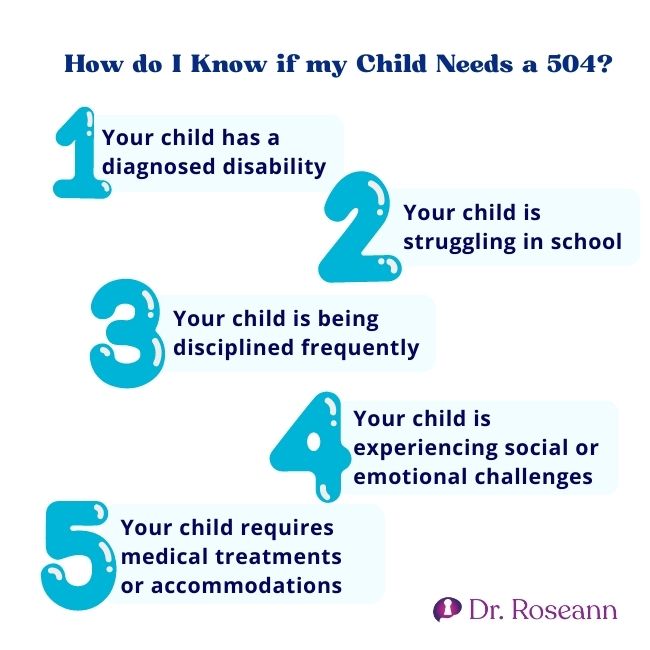
Your child is being disciplined frequently: If your child is commonly disciplined for behavior issues, a 504 plan may help address the underlying problems causing the behavior.
Your child is experiencing social or emotional challenges: If your child is experiencing social or emotional difficulties impacting their ability to learn or participate in school, a 504 plan may help provide support and accommodations.
Your child requires medical treatments or accommodations: If your child requires medical treatments or accommodations, such as frequent breaks, access to medication, or a special diet, a 504 plan may help ensure their needs are met at school.
It can be challenging to discern if your child needs a 504 Plan or an IEP. Often, schools test students to determine if they need individualized instruction versus accommodations only in a 504 Plan. Therefore, discussing your concerns with your child's teacher or school counselor is vital to determine what will best support your child.
Chapter 25:
Comparing 504 Plans and IEPs
How do I Know if My Child Needs an IEP or a 504?
Parents should ask themselves several key questions to determine if their child needs specialized instruction through an IEP or accommodations though a 504 plan.
- What are my child’s strengths and needs?
- Are my child’s needs causing them to regress or fall behind their peers in learning or social functioning?
- Has my child received regular education assistance or had a 504 Plan but is still behind or unable to keep up with peers?
- Does my child have a disability that is impacting their education in any way, including academically (reading, writing, math) or functionally (emotionally, behaviorally, socially, attentionally, communication, physical skills, executive skills, or coping skills)?
- Does my child need to be directly taught strategies and specific skills to make progress in school?
- Does my child only need accommodations for equal access to instruction, such as extended time on tests, elevator access, upfront seating, enlarged text, etc.?
The point of these questions is to determine your child's strengths and weaknesses and if they require specialized instruction or accommodations. For your child or teen to qualify for an IEP, they must require specialized instruction to remediate their area of need. In addition, their disability must significantly impact their learning, and their deficit needs to be focused on specialized instruction.
A 504 plan is different because the child or teen doesn't need direct instruction for the student to keep up with their peers and instead needs accommodations.
Key Differences in 504 vs IEP
IEP | 504 Plan | |
Eligibility Criteria | Student must have a disability that affects learning | Student must have a disability that substantially limits one or more major life activities |
Evaluation Process | Comprehensive evaluation and assessment of needs | Evaluation to determine if student requires accommodations |
Level of Support | Specialized instruction and services | Accommodations and modifications |
Type of Support | Direct and individualized instruction and services. | Accommodations to provide access to the curriculum |
Educational Goals | Individualized goals based on student's needs and abilities | Accommodations to ensure equal access to education |
Legal Protection | Protected by the Individuals with Disabilities Education Act (IDEA) | Protected by Section 504 of the Rehabilitation Act |
Both IEPs and 504 plans are designed to support students with disabilities but differ in the level and type of support provided, as well as the eligibility criteria and legal protection. Therefore, working with your child's school and a qualified professional is essential to determine the appropriate plan for your child.
Chapter 26:
6 Factors to Consider When Deciding Between a 504 Plan and an IEP
When deciding between a 504 plan and an IEP for a child with a disability, there are several factors to consider:

- The student's needs: Consider the nature and severity of the student's disability, and whether it requires specialized instruction or just accommodations to access the general education curriculum.
- The student's goals: Consider the student's educational goals and whether they require individualized instruction or accommodations to achieve those goals.
- The level of support required: Consider whether the student requires direct and individualized instruction, or just accommodations to access the general education curriculum.
- The eligibility criteria: Consider whether the student meets the eligibility criteria for an IEP or a 504 plan, based on their disability and how it impacts their ability to learn and participate in school.
- Legal protections: Consider the legal protections afforded by an IEP versus a 504 plan, including the rights to due process and free and appropriate public education.
- The development process: Consider the development process for each plan, including who is involved, how often the plan is reviewed and revised, and what services and accommodations are provided.
When deciding between a 504 plan and an IEP, it is crucial to consider these factors. Just because your child has a diagnosis doesn't mean they are eligible for an IEP or 504 Plan. Their disability must substantially impact their learning, behavior, or social functioning. Educate yourself to become your child's advocate, or hire an educational advocate or special education attorney to help you through this process.
Chapter 27:
504 Plan vs. IEP: Which is More Appropriate for Your Child's Needs?
It can be challenging to understand when your child or teen may need a 504 plan or special education services, especially when you are figuring this out on your own. While an advocate or special education attorney can help you in this process, using resources to educate yourself, such as Pete Wright, Esq's website, is essential to helping your child.
Here are examples of when a 504 or an IEP may be more appropriate to support your child.
Examples of When 504 Plan May Be More Appropriate than an IEP
- A student has a disability that does not require specialized instruction but requires accommodations to access the general education curriculum, such as extended time on tests, preferential seating, or assistive technology.
- A student has a medical condition that requires accommodations, such as diabetes or asthma, but does not require specialized instruction.
- A student has a disability that affects their ability to participate in school activities, such as mobility issues, but does not require specialized instruction.
- A student has a disability that does not meet the eligibility criteria for an IEP, but still requires accommodations to ensure equal access to education.
Example of When IEP May Be More Appropriate Than a 504 Plan
- A student has a disability that significantly impacts their learning ability and requires specialized instruction, such as a specific learning disability, autism, or intellectual disability.
- A student has a disability that requires related services, such as speech therapy, occupational therapy, or counseling, in addition to specialized instruction.
- A student has significant behavioral challenges that require individualized support and specialized instruction to address the underlying issues.
- A student requires a more individualized education plan with measurable goals and objectives and progress monitoring and reporting, which can be provided through an IEP.
Chapter 28:
7 Tips for Advocating for Your Child During the 504 Plan or an IEP Process

Advocating for your child's unique and special needs in education is crucial to ensuring they receive the support they need to succeed in school. When you advocate for your child, you can help ensure they have the same opportunities as their peers, including access to appropriate curriculum, instruction, and extracurricular activities.
By advocating for your child's educational rights, you can also help ensure they receive accommodations or individualized support that meets their unique needs. For example, it might include specialized instruction, accommodations, and related services like speech or occupational therapy. With the proper support, your child can succeed academically and develop essential life skills like self-advocacy.
Preparing for the school meeting is essential to feel ready and confident in this mysterious and stressful process.
Advocating for your child's educational rights requires collaboration between parents, educators, and other professionals. By working together, you can help your child succeed and ensure they receive the support they need to thrive in school and beyond.
- Learn about your child's rights: Familiarize yourself with the laws and regulations governing special education and accommodations in your state, such as the Individuals with Disabilities Education Act (IDEA) and Section 504 of the Rehabilitation Act.
- Be prepared: Gather documentation, such as medical records and evaluations, to support your child's needs. Write down your child's strengths, challenges, and any relevant information that will help the school understand their needs.
- Communicate effectively: Establish open communication with your child's teacher, school counselor, and other professionals involved. Be clear and concise in your communication, and ask questions if you need help understanding something. Offer suggestions and provide resources.
- Work collaboratively: Collaborate with the school to develop a plan that meets your child's needs. Advocate for your child's needs while working collaboratively with the school but be bold and ask for support and assert your rights. The laws are clear, and sometimes you must vocally advocate for your child.
- Keep records: Document, document, and document! Keep detailed records of all communication and meetings related to your child's plan. It will help you keep track of the progress and ensure that the plan is being implemented effectively.
- Seek support: Seek support from other parents of children with disabilities, advocacy organizations, and legal advocates if needed. Many families join our FREE parent community or listen to my It’s Gonna Be OK! podcast to get actionable tips and tools. These resources can provide valuable guidance and support in the advocacy process.
- Follow up: Follow up regularly with the school to ensure that the plan is implemented effectively and monitor your child's progress. Advocate for additional support if needed.
By educating yourself and working closely with the school, you can ensure your child receives the support they need to succeed in the classroom. If you think your child needs reasonable accommodations or specific individualized instruction to succeed in school, they probably do.
Having tested hundreds of children with a variety of issues that interfere with learning including, ADHD, emotional and behavioral issues, ASD, NVLD, concussion, LD, dyslexia, math disability, PANS/PANDAS, Lyme Disease, anxiety, social anxiety, depression, neurological and neurodevelopmental issues, and more, what I can tell you is simply understanding what accommodations your child needs under 504 or in an IEP, is a huge hurdle.
That is precisely why I created this FREE School Accommodations Guide for parents, so you can flip through and find suitable accommodations for your child's needs.
Grab my Ultimate Guide to 504 Accommodations to get detailed accommodations for the biggest issues impacting children and teens at school: attention, executive functioning, memory, anxiety, and more than 20 issues that impact learning, attention, and emotional functioning at school.

School Accommodations to Become
Your Child’s Best Advocate
➡️ Get the ultimate accommodations guide that has all of “the meat and none of the potatoes” with accommodations for more than 30 common issues and conditions
➡️ The exact accommodations you need for any school meeting or letter from a seasoned school psychologist and IEP and 504 meeting veteran
➡️Come prepared with the accommodations requests that actually can help your child at school
Chapter 29:
Getting support at school through a 504 Plan or IEP are two great ways to support your child's or teen's learning. Having the right educational plan can dramatically impact your child today and set them up for lifetime success.
Therapy for your special needs child is important and there are many things you can do to support your child on your own to improve their brain and emotional development. I know it feels overwhelming but empowering yourself with knowledge and taking small steps is where to start!
There is so much a parent can do differently. Instead of feeling like you are spinning your wheels, we have to look to science to see what changes and calms the brain. Focusing on gaining essential coping skills will help them self-regulate so they can pay attention, learn and take action not just in the classroom but at home too.
You also need support from like minded parents who want to see their children thrive and you can get that by joining my free Community, Natural Parenting Solutions.
More Resources for School Accommodations
- ADHD 504 Plan Examples
- 504 Plan for Teachers
- 504 Plan for Students With Dyslexia
- 504 for Executive Functioning: Helping Your Child Succeed in School
- 504 for Anxiety: Getting Support in the Classroom
Citations:
U.S. Department of Education. (2021). A guide to the individualized education program. Retrieved from https://www2.ed.gov/parents/needs/speced/iepguide/index.html
U.S. Department of Education. (2016). Parent and Educator Resource Guide to Section 504 in Public Elementary and Secondary Schools. Retrieved from https://www2.ed.gov/about/offices/list/ocr/docs/504-resource-guide-201612.pdf
Wrightslaw. (n.d.). Section 504 & the ADA. Retrieved from https://www.wrightslaw.com/info/sec504.index.htm
Always remember… “Calm Brain, Happy Family™”
Are you looking for SOLUTIONS for your struggling child or teen?
Dr. Roseann and her team are all about solutions, so you are in the right place!
There are 3 ways to work with Dr. Roseann:
You can get her books for parents and professionals, including: It’s Gonna Be OK™: Proven Ways to Improve Your Child’s Mental Health, Teletherapy Toolkit™ and Brain Under Attack: A Resource For Parents and Caregivers of Children With PANS, PANDAS, and Autoimmune Encephalopathy.
If you are a business or organization that needs proactive guidance to support employee mental health or an organization looking for a brand representative, check out Dr. Roseann’s media page and professional speaking page to see how we can work together.
Dr. Roseann is a Children’s Mental Health Expert and Therapist who has been featured in/on hundreds of media outlets including, CBS, NBC, FOX News, PIX11 NYC, The New York Times, The Washington Post,, Business Insider, USA Today, CNET, Marth Stewart, and PARENTS. FORBES called her, “A thought leader in children’s mental health.”

She is the founder and director of The Global Institute of Children’s Mental Health and Dr. Roseann Capanna-Hodge. Dr. Roseann is a Board Certified Neurofeedback (BCN) Practitioner, a Board Member of the Northeast Region Biofeedback Society (NRBS), Certified Integrative Medicine Mental Health Provider (CMHIMP) and an Amen Clinic Certified Brain Health Coach. She is also a member of The International Lyme Disease and Associated Disease Society (ILADS), The American Psychological Association (APA), Anxiety and Depression Association of America (ADAA) National Association of School Psychologists (NASP), International OCD Foundation (IOCDF) International Society for Neurofeedback and Research (ISNR) and The Association of Applied Psychophysiology and Biofeedback (AAPB).
© Roseann-Capanna-Hodge, LLC 2023
Disclaimer: This article is not intended to give health advice and it is recommended to consult with a physician before beginning any new wellness regime. *The effectiveness of diagnosis and treatment vary by patient and condition. Dr. Roseann Capanna-Hodge, LLC does not guarantee certain results.




